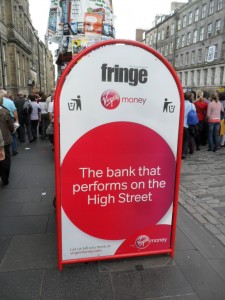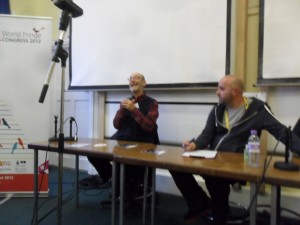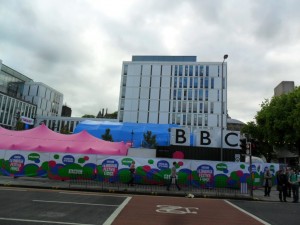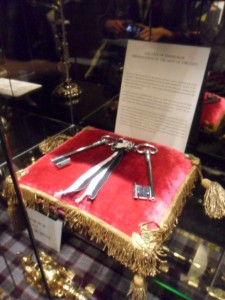World Fringe Congress Report #3: Retaining the Fringe Edge or Show me the Money!
The second day of the World Fringe Congress, Friday August 17, had a jam-packed schedule of panel discussions, break-out sessions, and a reception chez the Lord Provost (Edinburgh’s mayor), leaving absolutely no time to attend any shows at the Fringe, Forest Fringe or Free Fringes. The themes I narrowed in on were seemingly contradictory. Fringe producers expressed both a desire to “retain the edge” of their festivals and an obsession to find money – and lots of it!
Following a continental breakfast, delegates were invited to a panel on the theme of expansion called Growth and International Aspirations – is bigger better? The Chair, Graham Sheffield, is a musician cum-arts administrator with a great sense off humour who works for the British Council, a funding body for artists. He described the Fringe as “oppositional, subversive, [and] other of the mainstream,” and took delight in teasing the panelists who strayed from his ideas about the Fringe. For example, when panelist Robin Gillette of the Minnesota Fringe described the system she uses of quotas, a $400 fee, training programs and putting a cap on the number of shows to “develop audiences”, he cracked in his impeccable British deadpan: “It sounds rather Stalinist to me…Risk is one of the thrills at the fringe. It seems you have removed a lot of that. I don’t mean to be pejorative, but it doesn’t sound very American to me.”
We also heard from people like Greg Clarke, Chief Executive of the Adelaide Fringe, who was happy to report that almost all of the corporate media in his city, plus a bank, were sponsors of the long-running event which has now reached gigantic proprtions. Adam J.K. Potrykus, an organizer with STOFF (Stockholm’s young Fringe), was also interested in finding larger corporate sponsors for his event, while Sanjoy Roy, a producer from Fringe-less India, mulled over the idea of establishing a Fringe festival in his home country. “Everything is a Fringe in India,” he noted, adding “Arts are part of the bloodstream.”
What struck me the most about the panel were the complex formulae each Fringe Festival had regarding marketing budgets, quotas on the numbers and types of artists, pay-to-play fees, percentages of sales being split between artists and festivals, and other mathematical equations designed to create what Potrykus called “an intimate setting” and a “Fringe community”. He was eager to know how long it takes to get “established”, saying “We want to get bigger sponsors,” while conceding “we are still building the Fringe brand”. On the question of government sponsorship, all agreed that it was highly desirable, prompting Roy to inject: “Fringes are seen as anarchic spaces. Should governments fund anarchy?” Towards the end of the discussion the wise-cracking Chair asked “Is your festival a mirror of yourself?” There was denial all around from the Fringe administrators.
My impression, which would be repeated throughout the day, was how very un-Fringe-like it seemed to concoct and maintain Fringe Festivals using such blatant corporate methodology. Thinking back to 1947 when pissed off artists played on the fringe of the Edinburgh International Festival after being snubbed, I wondered what they would have thought about artist quotas, cross-branding, and paying fees to play in their artistic protest against the establishment.
Various break-out sessions followed, and I attended one callled It’s NOT All About The Money: Engaging with local funding bodies and authorities without talking about cash. Anita Clarke, an arts administrator with Creative Scotland, recommended schmoozing with government funding bodies (“build a relationship”) until they decide to fund Fringe Festivals, suggesting they be branded as “arts markets” that give “international profile” to host countries by providing a “platform”. She mentioned a British Arts Minister who once claimed “I’ll take money from anyone, even the mafia!”, and suggested the best way to sell the Fringes to officials is to portray a “sense of endeavour.” When the circle was opened up for discussion most other producers lamented that there was never enough funding from government bodies and expressed a great desire for more. When I pointed out that at the infringement festival we try to operate on as little money as possible (in Montreal we just produced over 50 performances on less than $1000), shocked eyebrows shot up across the room.
The next break-our session was the one I was looking forward to the most. Entitled Growing Pains. How do you retain your ‘Fringe’ edge as your festival grows?, this session was facilitated by Holly Payton-Lombardo, the main organizer of the World Fringe Congress, with Greg Germain, President of the Festival OFF d’Avignon as a featured expert. Germain suggested that his festival maintains its edge because artists can play for 23 days, meet the public, get media exposure and see the work of other artists.
Recalling the older days of the Montreal Fringe before it was trademarked, I tended to agree with him that these are the main reasons we created the Fringe in our city. What made the Fringe edgy was that it was our own event where we could do as we please artistically and then showcase our often-edgy work to what was then a very conservative theatre scene. Our message was that we didn’t need the entrenched system of auditions, producers, money and hierarchy and to create theatre – we could do it ourselves, in our own way, on a shoestring budget, and then invite others to share in our controversial and unconventional artistic utopia.
However, those were the days before the Fringe was trademarked in Canada and taken over by corporate interests and “professional” arts adiministrators. Having never been to the Festival OFF d’Avignon, I could not comment on what sounded like a very similar festival to the pre-corporate Fringe.
Once the floor was opened up for discussion, I readily proposed my own theory: the more corporate a Fringe becomes, the more it loses its edge and the more extinguished its spirit becomes. I explained how Canadian arts journalists have concluded that “the edge isn’t there any more” at the Fringe, and then, to put things in a local perspective, quoted The Guardian: “Edinburgh performers bid to reclaim the ‘true spirit’ of the fringe: The Edinburgh fringe opens to a backdrop of rising discontent at its costs and criticism that it has lost its edge.”
I then launched into my own story about helping establish the Montreal Fringe, living abroad for several years, and then returning to see it under new management and trademarked. I described how my show, Car Stories, was kicked out of the Fringe Festival after we criticized a corporate media sponsor who posed a conflict of interest (because they were both funding the festival and reporting on it).
I argued that it wasn’t so much a case of “retaining the edge,” but rather trying to restore any semblance of an edge when many of the now-corporate Fringes are about as sharp as a butter knife. I recommended not only creating safeguards to protect the Fringe from excessive corporate manipulation, but also to curtail overzealous “professional” arts adminstrators who act as cultural gatekeepers and to actually connect with what is edgy in the society, such as the Occupy Movement or controversial activist arts such as the Pussy Riot scandal.
The question was put out there: when does a Fringe lose its edge? Ironically, it was Mike Marinaccio, Producer of the Disney-sponsored Orlando Fringe Festival, who said: “When corporations or governments call the shots, the edge is lost.” While I agree wholeheartedly, I think it is only half of the equation. The other way the edge can be dulled is by administrators acting a cultural gatekeepers, deciding who can play, how much it costs, which sponsors will be prominent and how much visual pollution/corporate spam will be tolerated, amongst other issues.
I argued that to have an edge, the Fringe must resemble the original version in 1947 when artists took charge and challenged the status quo with their artistic brilliance. When administrators decide what a “Fringe” is, it creates an ersatz version, a marketed PR version of what a real, edgy Fringe actually is. A real Fringe empowers artists and community because it is created and run by them, whereas a branded Fringe run by “professional” administrators benefits mostly those administrators, who can now collect salaries and be associated with the cool-factor that comes from the original Fringe. Simply put, it’s fairly insidious a form of co-opting. That being said, administrators whose sole objective is to ensure artists on the Fringe are supported, as the Festival Fringe Society employees in Edinburgh claim, strike me as being more legitimate.
The best way to do it, in my opinion, is by using the infringement model whereby not only do administrators support the artists, but they also ensure the artists are not compromised in any way, unlike the Edinburgh Festival Fringe Society that associates them with unethical sponsors, charges then hundreds of pounds to appear in their program, insists on selling 25% of their tickets, and sells off public space to corporate sponsors, creating visual pollution and a very un-Fringe like and corporate-looking environment, not unlike a shopping mall.
The next event was another panel called How do you promote your Fringe and ensure its reputation when you don’t control quality? I found this one odd because the Fringe was never meant to be about “quality” but rather about open-access. What was most interesting about this panel was a freelance journalist named Mark Fisher who wrote a book called The Edinburgh Fringe Survival Guide: How to Make Your Show a Success, and was also doing a play at the Fringe of a similar nature. I picked up a copy of his book for a tenner and gave him some information about the infringement. I informed him that no journalist in Europe had covered it yet, despite the levels of media saturation seen in places like Buffalo, New York, or to a lesser extent, in Montreal (infringement is still blacklisted by many arts journalists there). Glancing at the book, I could see that it confirmed what most artists were reporting on the street – it is almost impossible to play at the Edinburgh Fringe without going into serious debt.
The final break-out session I attended was called:
It IS all About the Money: Sponsorship and investment for your Fringe
* How to attract major sponsors and how to keep them.
* How to get funding when you don’t make the work.
* How to calculate your financial value.
* Fundraising & other sources of income, such as business, local authorities, arts funding bodies, crowd funding.
This one was jam-packed with Fringe producers lining up. I almost expected them to start yelling: “Show me the money!”, like some cheesy American infomercial. The man behind this workshop even had a name that sounded like a bank: Barclay Price. He’s the Director of Arts & Business Scotland, an organization that matches artists with sponsors (for a fee, of course). Barclay was a slick, PR-type who smoothly sold the crowd on the idea of seeking as much sponsorship as possible from a wide variety of sources.
When the floor opened, I pointed out that both the Fringe and the Edinburgh International Festival it originally protested against for elitism shared the same sponsor, Virgin Money. When I suggested that this corporate arrangement damaged the Fringe’s brand, he was dismissive. He suggested Virgin Money was actually a very good brand, that nobody cared about the branding, but rather the arts, and wrapped up with: “Don’t put your political views on others.” Feeling brushed away like a fly, I watched the other producers ask numerous questions about the best ways to approach corporations (it seems that beyond the Marketing Department, there is now a “Corporate Social Responsibility” Department in many corporations that essentially tries to do PR to make them look good, much like Greenwashing).
Annoyed, I concocted the type of question that I thought would surely put Barclay between a rock and a hard place: “Mr. Price,” I asked, “Do you think that it is acceptable that the Saskatoon Fringe has been renamed the PotashCorp Fringe, and if so, what do you think the best corporation would be to name the Edinburgh Fringe after?” There was an audible gasp in the room at the thought of re-naming the grand-daddy of Fringes after a corporation, but Barclay didn’t bat an eyelash. He suggested that Edinburgh Fringe and Pepsi would be a good match, claiming “It’s an adult approach.” Following the session I gave him my infringement materials and suggested he at least be aware of the opposing point-of-view. He graciously accepted them, thanking me with a polished Scottish brogue. As I left the hall I thought how he would be a perfect actor for selling a bank or some financial “services” on television.
We finally left SummerHall, en route to a reception with the Lord Provost (mayor) of Edinburgh. On the way we passed a giant tent sponsored by the BBC, where I imagine they were running their own version of a corporate Fringe inside.
Arriving at the City Chambers, the sort of governmental place I am rarely invited to, I breathed in all the pomp and dreamed what it would be like to receive the keys to the magnificent city. Then, suddenly, they appeared! En route to the reception, the giant set of keys were found practically glowing in a glass case in a hallway!
When I met the Lord Provost, the Right Honourable Donald Wilson, I shook his hand, introduced myself, and told him about the infringement festival, joking that maybe it would appear in Edinburgh one day. He chuckled and directed me to the free glasses of wine. Speeches were soon delivered by the Lord Provost and the Culture Minister, Fiona Hyslop, MSP Cabinet secretary for Culture and External Affairs. This was standard fare, welcoming us to the city, encouraging our work, and advising us to return again and again in the future.
I gave the Culture Minister the infringement information on her way out to another function. I thought how cool it was that I was able to access all the high-level officials to inform them directly about our cultural movement of infringement. In Quebec and Canada it is very difficult to access politicians, and from my own experience, most of the time they don’t listen anyways.
We had a break after the reception, so I dined with the edgy Amy Wragg – director of the SWITCH (Ipswitch) Fringe. I tasted the traditional Scottish haggis, paprika chicken, and profiteoles, washing it down with more red wine. The evening ended at the Underbelly, a part of uber-corporate Bristo Square’s Abattoir Bar. This private, invitation-only bar catered to “Industry insiders” for the “Big Four” venues that have been highly criticized for damaging the equal nature of the Fringe and ruining its equilibrium. Why we were invited there was anyone’s guess, versus, say, an authentic Fringe venue. In any case, after a few more drinks in the packed establishment, it was time to go home.
After walking back to our quarter we decided to drop in for a nightcap at a nearby pub called the Blue Blazer. The delicious Scottish whiskey tasted somewhat like a campfire. I slept like a log.
***
Read more from this series:
Preview: World Fringe Congress to welcome infringement festival
World Fringe Congress Report #1: First Impressions
World Fringe Congress Report #2: The word on the street and Congress opening
World Fringe Congress Report #3: Retaining the Fringe Edge or Show me the Money!
World Fringe Congress Report #4: World Fringe Fair, Open Spaces and Members Only Clubs
World Fringe Congress Report #5: Searching for the Fringe and Reflections







